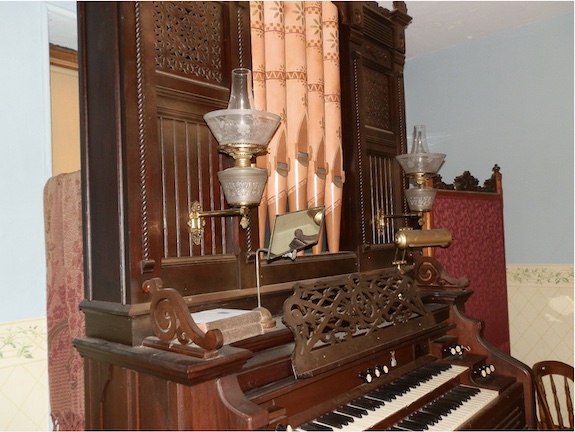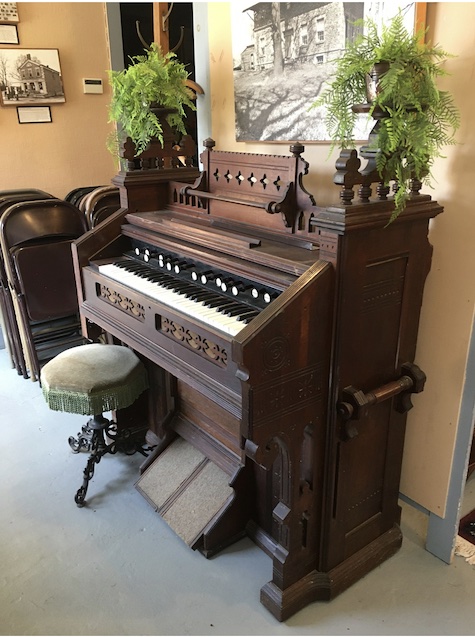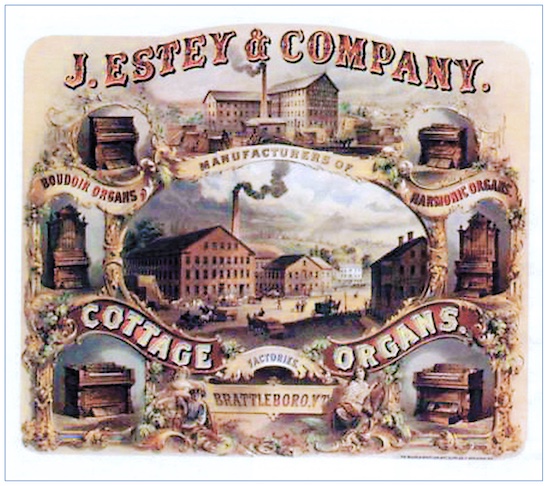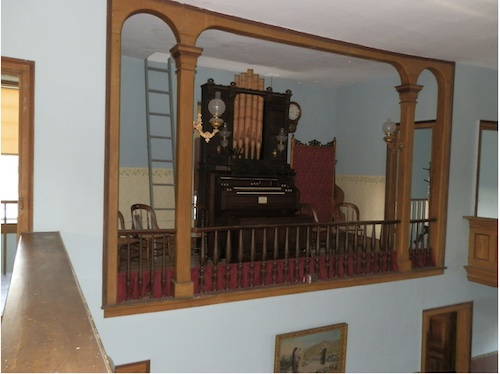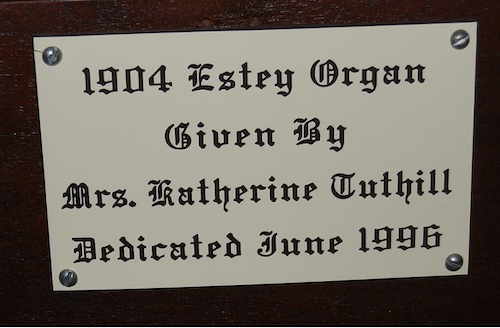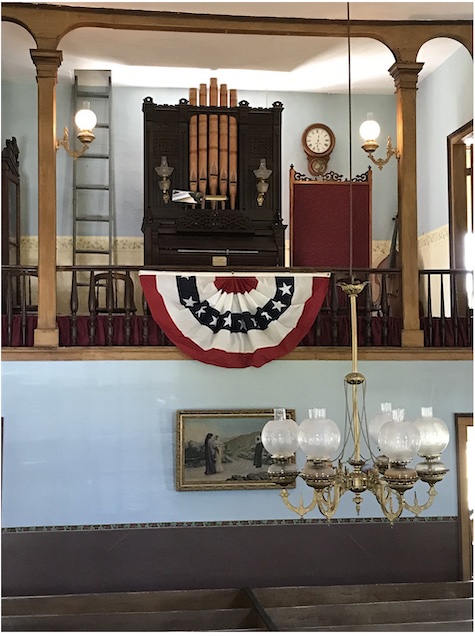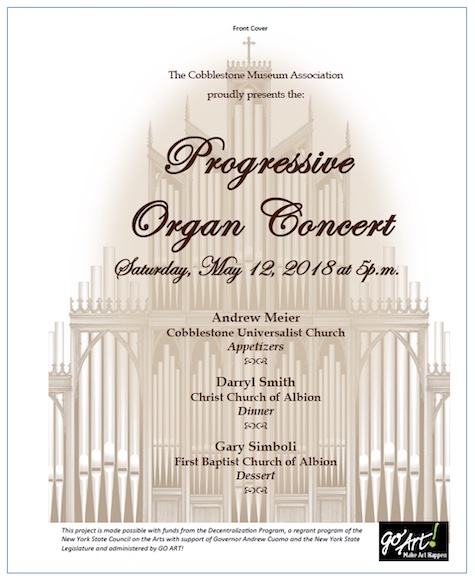Historic Childs: Musical Instruments, Part 2 (The Estey Reed Organ)
By Doug Farley, Cobblestone Museum Director – Vol. 3 No. 11
GAINES – In this installment of “Historic Childs,” we take a look at another musical instrument in the collection of the Cobblestone Museum. This 1904 Estey Reed Organ, by far the largest musical instrument in our collection, is now at home at the National Historic Landmark Cobblestone Universalist Church (1834). It is unusual by appearance, in that the rank of pipes on top of the organ are strictly non-functional and have been placed there to give the illusion that the instrument is a pipe organ (i.e., fake pipe top).
The first organ in the Universalist Church was perhaps a small Melodeon that proved insufficient for the size of the building. It was replaced by a pump organ, and later, the one shown above. This organ has now been moved to the lower level of the Church following the donation of the Estey Organ. Notice the foot petals that pumped bellows that provided the moving air that produced the musical notes.
The Cobblestone Universalist Church followed the custom of the time and placed the organ in the choir loft located in the rear of the sanctuary and the preacher at the opposite end. At one time, all of the churches in Albion followed this tradition, until more modern times saw all of the churches (except the historic Cobblestone Church and St. Joseph’s Catholic Church) place choir and clergy in the same area in the sanctuary.
The Estey Reed Organ was built for church performance in Brattleboro, Vermont in 1904, and features two full keyboards and a pedal board. Estey Organ Company was founded in 1852 by Jacob Estey, who bought out another Brattleboro manufacturing business. At its peak, the company was one of the world’s largest organ manufacturers, employing about 700 people, and selling its high-quality items around the world. Estey built around 500,000 to 520,000 pump organs between 1846 and 1955. Estey also produced pianos, made at the Estey Piano Company Factory in New York City.
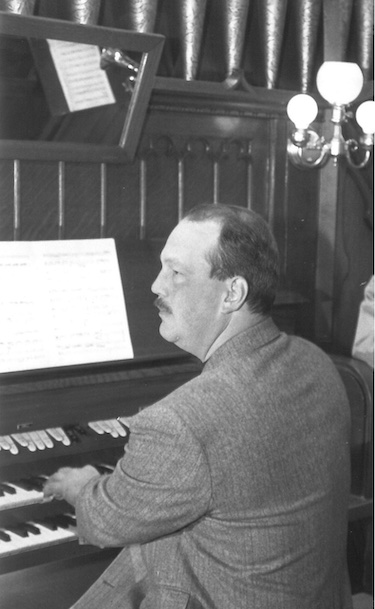
Wade Gidley at the Pullman Memorial Church Centennial Celebration, April 17, 1994
The Museum’s Estey Organ was secured for the Cobblestone Society in 1996 by Wade Gidley, a local organist that later moved to Texas. It was acquired through a donation by Mrs. Katherine Tuthill of Williamsville NY. The organ was moved from its former home in Williamsville by movers who carried it upstairs to its current location in the Cobblestone Church organ/choir loft.
Wade Gidley was born in Albion and lived in Orleans County most of his life. His love for the organ began when he was a small child. He studied under the late Harold Suzanne in Medina, taking lessons on the pipe organ at the old Masonic Temple in Medina and also on the organ of the First Baptist Church there.
He received his first appointment as a resident organist at the age of 14 at the Lyndonville United Methodist Church. He also played at St. John’s Lutheran Church at County Line in the Town of Yates and the Knowlesville United Methodist Church.
Following High School, Wade spent three years in the Army as Chapel Organist at Fort Leonard Wood in Missouri, and while stationed in the Federal Republic of Germany, he played at the Sacred Heart of Jesus Parish in the Hanan Military community. Upon returning to the United States, he played at the Pullman Memorial Universalist Church, Albion; First Baptist Church, Medina; and St. Patrick’s Episcopal Church in Cheektowaga.
Announcement of the intended organ donation was made to the Cobblestone Board of Trustees at their April meeting in 1996, and the board, along with Museum Director/Curator Bill Lattin, quickly began to plan a dedication service for the “new” organ to be held on June 1st.
Pat Morrisey volunteered to prepare refreshments and Mary Anne Braunbach offered to video-tape the event so it could be shared with Mrs. Tuthill, the donor, who was not able to attend.
Mr. Gidley, assisted by Ken Root, began to make preparations for the permanent installation of the organ in the church choir loft. The men installed a four-inch pipe in the attic for the blower motor, which cut down on the noise. In the organ’s earlier placements, it would have been “powered” by bellows which were operated by a “blow-boy.” This young man would have provided the man-power needed to force air into the reed organ by pumping bellows, usually located behind a screen (shown above), so as not to be a distraction to the musician or audience.
A plaque was ordered to honor the donor, Mrs. Tuthill, who taught 6th grade for 45 years in the Buffalo Public Schools. She studied music at the University of Buffalo and played the organ and piano throughout most of her life. For 22 years, she led the Children’s Choir at the First Presbyterian Church of Buffalo.
When June 1st arrived, the Dedication was attended by 63 guests. Bill Lattin remarked that there were many first-time visitors among the guests. Following the Dedication in the sanctuary, guests retired to the Proctor Room in the lower level of the church to enjoy the delicious refreshments prepared by Pat Morrisey.
Throughout the years, the Estey Organ has continued to provide wonderful music, reminiscent of an earlier form of church music. In addition to countless weddings that have taken place over the years in the church since the organ’s arrival in 1996, the Estey organ has also provided music for hymn singing twice each year, when the congregation from the Pullman Memorial Universalist Church in Albion visits their old “stomping grounds” for summer services, usually held on the last Sunday of June and first Sunday of July. The later service is a community patriotic event that includes hymn singing as well as patriotic readings, designed to celebrate the Fourth of July.
On May 12, 2018, the Cobblestone Museum held its first Progressive Organ Concert, and its own Estey Organ became the first stop on the tour that day. Mr. Andrew Meier, principal organist at Trinity Lutheran Church in Medina, performed selections designed to highlight church music from the early 1900s and demonstrated the full melodic function of the instrument.
Born and raised in Medina, Andrew Meier graduated from Medina High School in 1997, and graduated magna cum laude in political science from the University of Rochester in 2001 and cum laude from the Syracuse University College of Law in 2004.
The 2018 Progressive Organ Concert included a beef bourguignon dinner prepared by Maarit Vaga and served in the Fellowship Hall at Christ Episcopal Church, Albion. A sell-out crowd of 80 guests filled the hall. Now that COVID is declining (we hope) the Cobblestone Society & Museum again hopes to have another Progressive Organ Concert in the future.






















